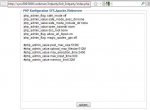- Mitglied seit
- 15. Mai 2008
- Beiträge
- 21.900
- Punkte für Reaktionen
- 14
- Punkte
- 0
Auf meiner DS509+ ist ein Phänomen aufgetreten, dass sich der System-Apache durch die Modifikationen des Init_3rdparty.spk nicht mehr ausführen ließ.
Symptome
- der DSM lässt sich nicht mehr aufrufen
- der DSM lässt sich nach einer Init_3rdparty.spk-Installation nicht mehr aufrufen
- wenn man mit Telnet/ssh auf die DS geht findet man mit ps keinen httpd mehr
Ursache
- die /usr/syno/apache/conf/httpd.conf-sys enthält am Ende die durch das Init_3rdparty.spk Direktiven zum Nachladen der PHP-Funktionalität (das ist ja der Grund für dieses Skript)
Mit dieser Direktive läßt sich der System-Apache nicht (re)starten:
Ein ps zeigt an, dass kein Apache läuft. Warum das so ist, muss ich noch genau analysieren. Vermutlich tritt die Situation nur nach einem Firmware-Upgrade ein.
Lösung des Problems
Per telnet/ssh sind die meisten der folgenden Schritte durchzuführen:
1] Anfertigen einer Kopie der Datei /usr/syno/apache/conf/httpd.conf-sys: cp /usr/syno/apache/conf/httpd.conf-sys /usr/syno/apache/conf/httpd.conf-sys.mod
2] Umkopieren der Backup-Konfigurationsdatei: cp /usr/syno/apache/conf/httpd.conf-sys.bak /usr/syno/apache/conf/httpd.conf-sys
3] Restart des System-Apache: /usr/syno/etc/rc.d/S97apache-sys.sh restart
4] Kontrolle, ob der System-Apache läuft (ps, Anmelden im Browser)
5] im DSM: Einrichten der (User-)Webdienste: Web Station aktivieren und MySQL aktivieren. Bei PHP-Einstellung muss man nichts ändern.
6] Kontrolle, ob der User-Apache läuft (ps)
7] Umkopieren der Mod-Konfigurationsdatei: cp /usr/syno/apache/conf/httpd.conf-sys.mod /usr/syno/apache/conf/httpd.conf-sys
8] Restart des System-Apache: /usr/syno/etc/rc.d/S97apache-sys.sh restart
9] Kontrolle, ob der System-Apache läuft (ps, Anmelden im Browser)
Es kann sein, dass es auch andere Selbstheilungskräfte gibt (20x neu booten, Voodoo). Eines meiner Problem mit der neuen Firmware ist über dieses Vorgehen gelöst worden.
Für alle, die das Init_3rdparty.spk nicht installiert hatten oder wieder deinstalliert haben, gilt der folgende Satz:
Erst den User-Webdienst zusammen mit MySQL einrichten/aktivieren und dann erst das Init_3rdparty.spk installieren bzw. ausführen.
Itari
PS. Fragen zum Vorgehen sollte man im Firmware-Forum oder im 3rd-partyapps-Forum posten. Wenn jemand Ideen hat, warum das Problem aufgetreten ist oder alternative Lösungen kennt, dann wäre hier der richtige Platz.
Symptome
- der DSM lässt sich nicht mehr aufrufen
- der DSM lässt sich nach einer Init_3rdparty.spk-Installation nicht mehr aufrufen
- wenn man mit Telnet/ssh auf die DS geht findet man mit ps keinen httpd mehr
Ursache
- die /usr/syno/apache/conf/httpd.conf-sys enthält am Ende die durch das Init_3rdparty.spk Direktiven zum Nachladen der PHP-Funktionalität (das ist ja der Grund für dieses Skript)
Rich (BBCode):
LoadModule php5_module /lib/libphp5.soMit dieser Direktive läßt sich der System-Apache nicht (re)starten:
Rich (BBCode):
/usr/syno/etc/rc.d/S97apache-sys.sh restartEin ps zeigt an, dass kein Apache läuft. Warum das so ist, muss ich noch genau analysieren. Vermutlich tritt die Situation nur nach einem Firmware-Upgrade ein.
Lösung des Problems
Per telnet/ssh sind die meisten der folgenden Schritte durchzuführen:
1] Anfertigen einer Kopie der Datei /usr/syno/apache/conf/httpd.conf-sys: cp /usr/syno/apache/conf/httpd.conf-sys /usr/syno/apache/conf/httpd.conf-sys.mod
2] Umkopieren der Backup-Konfigurationsdatei: cp /usr/syno/apache/conf/httpd.conf-sys.bak /usr/syno/apache/conf/httpd.conf-sys
3] Restart des System-Apache: /usr/syno/etc/rc.d/S97apache-sys.sh restart
4] Kontrolle, ob der System-Apache läuft (ps, Anmelden im Browser)
5] im DSM: Einrichten der (User-)Webdienste: Web Station aktivieren und MySQL aktivieren. Bei PHP-Einstellung muss man nichts ändern.
6] Kontrolle, ob der User-Apache läuft (ps)
7] Umkopieren der Mod-Konfigurationsdatei: cp /usr/syno/apache/conf/httpd.conf-sys.mod /usr/syno/apache/conf/httpd.conf-sys
8] Restart des System-Apache: /usr/syno/etc/rc.d/S97apache-sys.sh restart
9] Kontrolle, ob der System-Apache läuft (ps, Anmelden im Browser)
Es kann sein, dass es auch andere Selbstheilungskräfte gibt (20x neu booten, Voodoo). Eines meiner Problem mit der neuen Firmware ist über dieses Vorgehen gelöst worden.
Für alle, die das Init_3rdparty.spk nicht installiert hatten oder wieder deinstalliert haben, gilt der folgende Satz:
Erst den User-Webdienst zusammen mit MySQL einrichten/aktivieren und dann erst das Init_3rdparty.spk installieren bzw. ausführen.
Itari
PS. Fragen zum Vorgehen sollte man im Firmware-Forum oder im 3rd-partyapps-Forum posten. Wenn jemand Ideen hat, warum das Problem aufgetreten ist oder alternative Lösungen kennt, dann wäre hier der richtige Platz.
Zuletzt bearbeitet:









